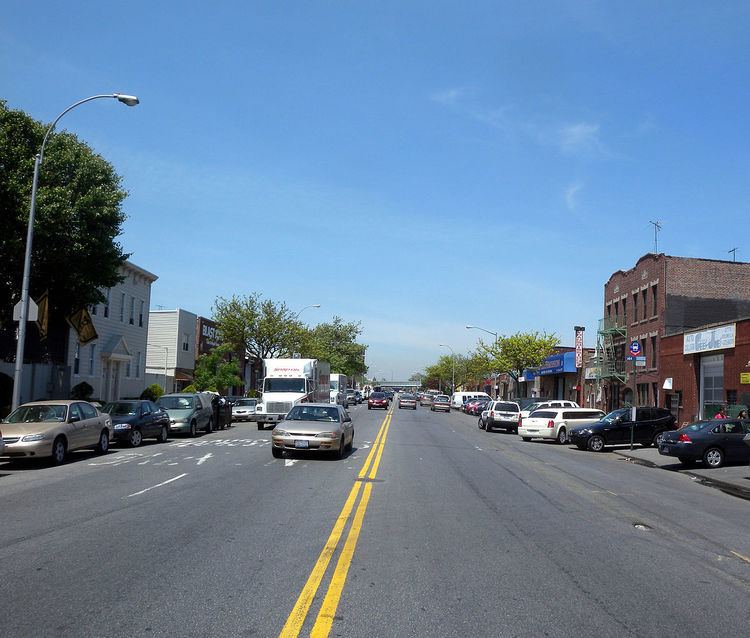Length 3.862 km | ||
 | ||
North end Bay Parkway (becomes Bay Ridge Parkway - former NY 439) | ||
Subway tour coney island stillwell avenue
Stillwell Avenue is a major north/south thoroughfare in southern Brooklyn and the central section of Coney Island. It is 2.4 miles (3.86 kilometres) long and begins at a dead end on Coney Island. Traffic is two way. The road goes north, leaving Coney Island, ending at Bay Parkway, where the road continues as the Bay Ridge Parkway (former Route 439). On December 11, 2008 it acquired the subsidiary name Polar Bear Club Walk, named for the Coney Island Polar Bear Club. The Stillwell Avenue/Surf Avenue intersection on Coney Island is the location of what is said to be the largest subway station in the world.
Contents
- Subway tour coney island stillwell avenue
- Map of Stillwell Ave Brooklyn NY USA
- Coney island stillwell avenue
- History
- Street description
- Transportation
- Mentions in Popular Culture
- References
Map of Stillwell Ave, Brooklyn, NY, USA
Coney island stillwell avenue
History
Stillwell Avenue was named after settler Nicholas Stillwell (1603-1671), who had a farm in the area and became the progenitor of an influential Brooklyn family by the same name.
Plans for Stillwell Avenue began in October 1926. The street was to stretch from Bay Parkway (its current northern terminus) and Neptune Avenue on Coney Island (0.4 miles (0.64 km) from the southern terminus). The project was to cost $331,500 and was certified by Brooklyn president James J. Byrne. Stillwell Avenue, at the intersection with Surf Avenue, is the location of an original Nathan's after the first one was torn down.
The New York Sun newspaper released a story on November 13, 2006 about plans to reinvigorate Coney Island. Most of it was for the amusement parks, including a roller coaster that would go in and out brand-new buildings along Stillwell Avenue. Where Stillwell Avenue meets the Riegelmann Boardwalk, the architect wanted to build a large waterpark and a three-story carousel.
Street description
Stillwell Avenue begins at the Atlantic Ocean on Coney Island, just north of the Riegelmann Boardwalk, occupying the position of West 14th Street. The road parallels Henderson Walk for a short distance to the intersection with Surf Avenue at 0.2 mile. Surf Avenue stretches parallel to the boardwalk on Coney Island. Neptune Avenue is the next intersection, intersecting at 0.4 mile. Soon afterwards, Stillwell Avenue crosses Coney Island Creek, which reaches into Lower New York Bay. Just after crossing the creek, Stillwell Avenue goes under the Shore Parkway, a section of the Belt Parkway system. Although it does not have an interchange with the road, Exit 6N on the westbound Shore Parkway is for Stillwell Avenue. Instead, the exit lets off at Avenue Z and accesses Stillwell within a mile. Bay 50th Street intersects just afterwards 1-mile (1.6 km). Stillwell Avenue passes Scarangella Park and intersects 86th Street at 1.6 miles (2.6 km). At 2.3 miles (3.7 km), there is an intersection with Kings Highway, which ends soon afterwards at Bay Parkway. Stillwell Avenue also comes to an end at Bay Parkway, 2.4 miles (3.9 km) from the beginning. The road virtually continues as Bay Ridge Parkway, a former street making up part of Route 439.
Transportation
At the Surf Avenue intersection on Coney Island, the largest elevated rapid transit terminal in existence, which shares a name with the avenue, is located on Stillwell Avenue. The station is also the most energy-efficient transit facility in the world. The station, originally opened in 1919, rebuilt and re-opened in 2004 provides access to the D F N Q trains. The other station located along Stillwell Avenue is the Bay 50th Street station in southern Brooklyn. Located in front of the John Dewey High School, the station services only the D train.
The B4, B64 New York City Bus-operated bus lines serve the avenue.
Mentions in Popular Culture
Stillwell Avenue is mentioned in the song 'Stillwell and Surf' by the band ¡Löco!.
